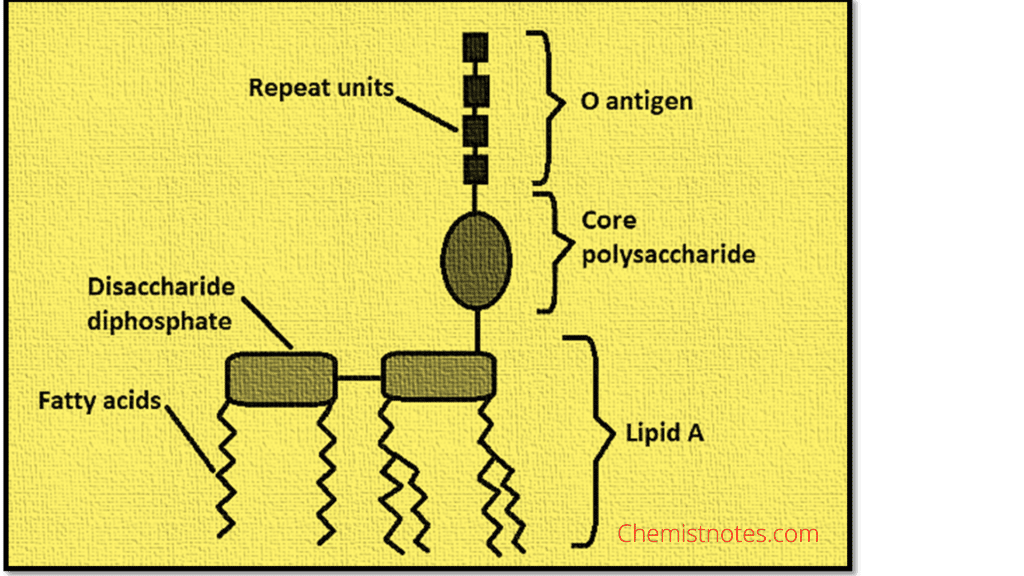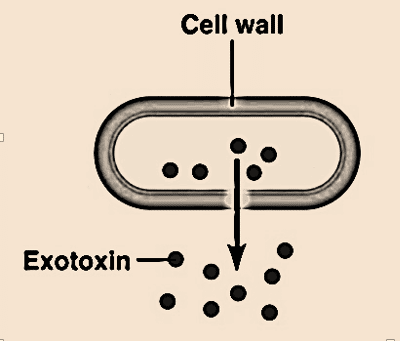Table of Contents
ToggleEndotoxin and exotoxin are the two forms of toxins that the bacteria produce to target other bacteria or host cells. The virulence components of bacteria that alter host cell function are called toxins. It can be used for creating biological weapons. They are often proteins or peptides that are produced by either gram-positive or gram-negative bacteria or microorganisms.
Generally, there are two main categories of toxins, and they are:
- Endotoxin
- Exotoxin
Endotoxin
Endotoxins (Endo + toxin = cell-associated toxin) are lipopolysaccharides that are secreted by bacteria or other microorganisms and are only released into the environment when they die. It is an essential component for the survival of bacteria.

Endotoxin is a substance found in cells and on chromosomal genes. Compared to exotoxins, they have a modest level of toxicity. Gram-negative bacteria typically produced them. Endotoxin typically ranges in molecular weight from 50 to 1000 kDa. In contrast to exotoxins, they are heat stable and have higher endotoxin enzymatic activity. Fever, vomiting, and diarrhea are just a few of the common symptoms that a person may have from an endotoxin.
An endotoxin has three components; Lipopolysaccharide (LPS): Lipid A moeity, the highly conserved core polysaccharide, and the species-specific O-antigen.

Some examples of endotoxin are E.coli, Shigella, Salmonella typhi, and Vibrio cholerae.
Exotoxin
Exotoxins (Exo+ toxin= outside of cell) are polypeptides that bacteria produce in their surroundings. These are usually proteins and act enzymatically or through direct action through the host cells and stimulate a variety of host responses.

Exotoxin is a substance that is typically found on extrachromosomal genes ( plasmids). These are produced by gram-positive bacteria, which makes them extremely toxic and hazardous. They have a molecular weight of roughly 10 KDa, are heat labile, and lack enzymatic activity. Exotoxins are highly immunogenic, filterable, and can be neutralized by antibodies. Moreover, it may play role in invasion. General symptoms shown by them are cytotoxin, neurotoxin, and enterotoxin.
Some examples are Streptococcus pyogenes, Bacillus cereus, and so on.
Difference between Endotoxin and Exotoxin
Below table shows the differences between endotoxin Vs exotoxin:
| Characteristics | Endotoxin | Exotoxin |
| Location | It is located on chromosomal genes. | It is generally located on extrachromosomal genes (plasmids). |
| Molecular size | Approximately 50-1000KDa | Approximately 10KDa |
| Sources | Produced by gram negative bacteria | Produced by gram-positive bacteria |
| Structural composition | Generally consisting of three elements: lipid A, Core oligosaccharides and O- specific polysaccharide also called antigen-O | It generally consists of an amino-terminal domain composed primarily of antiparallel beta structure. |
| Thermal stability | Heat stable | Heat labile |
| Enzymatic activity | Enzymatic activity is high. | No Enzymatic activity |
| Toxicity | Moderately toxic | Highly toxic |
| Potency | For toxins to cause diseases, a lot of them are needed. | Numerous host species can be affected by a single poison molecule. |
| Enzymes present | Catalase, fibrolysin, lgG proteases | Hyaluronidase, collagenase, nuclease, certain proteases |
| Symptoms | Fever, diarrhea, vomiting etc | Cytotoxin, Enterotoxin and Neurotoxin |
| Chemical nature | They are composed of lipopolysaccharide. | They are composed of polypeptide protein. |
| Resistance | Weakly immunogenic | Highly antigenic |
| Binding properties | Specific receptors not found. | Usually binds to specific receptors. |
| Denaturation | Cannot be denatured on boiling. | Gets denatured on boiling. |
| Diseases | Meningococcemia, sepsis, etc. | Tetanus, botulism, etc. |
| Immune response | Immune response is comparatively weaker. | Stronger ability to trigger immune response. |
| Conversion capacity | It can’t be converted into toxoids. | It can be converted into toxoids. |
| Vaccines | No effective vaccines available. | Effective vaccines are available. |
| Examples | E.coli, Vibrio cholerae, Salmonella typhi, etc. | Bacillus cereus, Bacillus anthracis, staphylococcus aureus, streptococcus pyogenes, etc. |
Published by: Pratiksha Chaudhary (Chemikshya)
Endotoxin and Exotoxin Video
FAQs
Difference between toxin and poison
Poisons are substances that harm living things when enough of them is absorbed, inhaled, or consumed. A toxic chemical produced by living cells or creatures is referred to as a toxin.
Which is more heat stable, endotoxin or exotoxin?
Endotoxins are heat stable.
Which is highly toxic, endotoxin or exotoxin??
Exotoxins are highly toxic.
Are Exotoxins gram positive or negative?
Exotoxins are gram-positive.
What kind of cell produces endotoxin?
Endotoxin is produced by gram-negative
Is salmonella endotoxin or Exotoxin?
salmonella is enodotoxin.
Size of endotoxin?
The size of endotoxin is 50-1000 kilo Dalton.






